#dungeons and dragons homebrew
Text

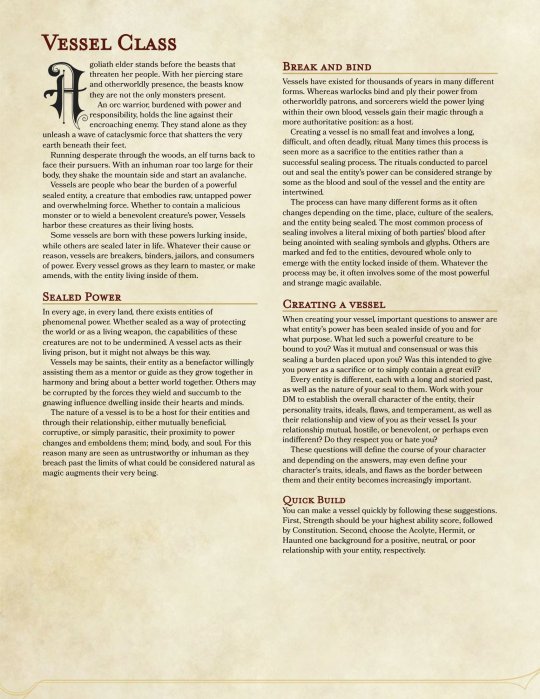

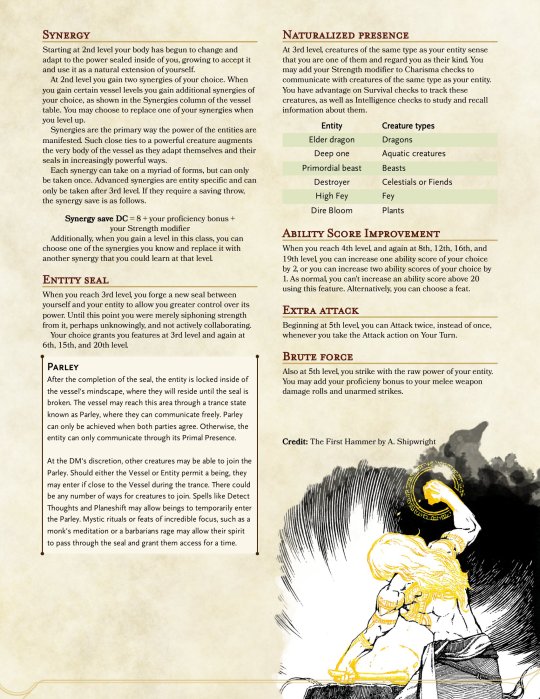







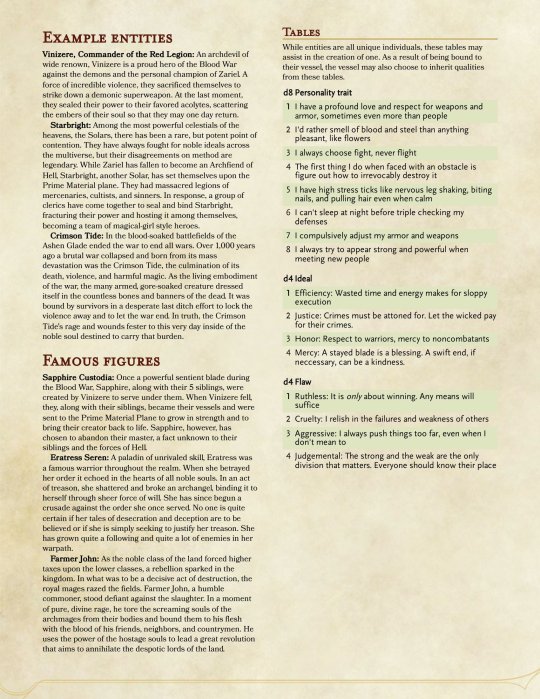
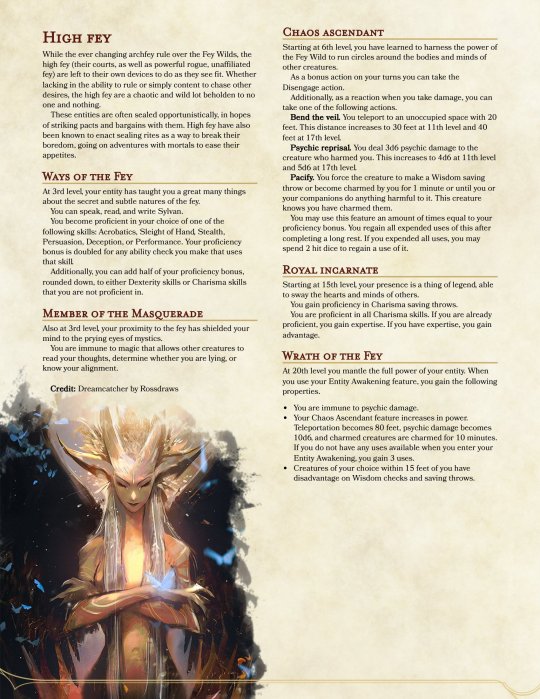


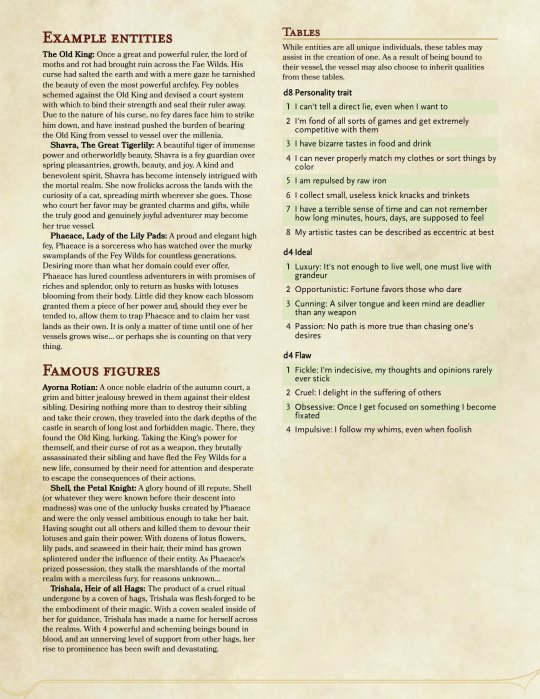




Introducing the Vessel class version 2.2!
It's been a long time for all of us, hasn't it? About 2 years ago this project started and now, slowly and surely, it closes in on its fully realized state
I already posted up the original subclasses: elder dragon, deep one, and primordial beast for all of your draconic, sea monster, and fuck off huge animal needs
Aaaand here we are with the 2nd batch!
The Destroyer, for ascended demons and rampaging angels
The High Fey, for the various tricksters of the Fey Wilds
The Dire Bloom, for supernaturally powerful flowers, trees, and what have you
As always I simply must thank my friend PJ, my collaborator, tester, and DM
My gf, who helped spark the Vessel class and plays the first ever vessel, Nia Rivers
And a special thank you to my dear friend Rowan who I lost very recently. The act of creating will save you. <3
As always you can find the full homebrewery document here: https://homebrewery.naturalcrit.com/share/n_swReh_PBe6
479 notes
·
View notes
Text

Subclasseptember Day 16: Weather
The Circle of Ruins - Homebrew Druid Subclass
Given their association with structures like Stonehenge, I'm surprised that this isn't already a thing.
Explicitly designed to be a tanky caster (unlike some subclasses *cough bladesinger cough*), with ways to help maintain concentration and further play into the delayed value that the Druid class already encourages. You broke my concentration on Call Lightning? Good thing I had a Moonbeam cooking that entire time. It also plays into some novel weaknesses, though - you're durable, but mobility is not exactly your strong suit. Endure as the ruins do.
#homebrew subclass#my homebrew#d&d 5e#homebrew#5e homebrew#dnd 5e homebrew#dnd homebrew#subclasseptember 2023#subclasseptember#subclass#subclass homebrew#5e dnd#5e#dnd 5e#ttrpg#dungeons and dragons#dnd#d&d 5e homebrew#dungeons and dragons homebrew#dungeons and dragons 5e#dnd dungeons and dragons#druid#druid dnd#dnd druid#d&d druid#d&d homebrew#d&d
239 notes
·
View notes
Text
Release the Krakens



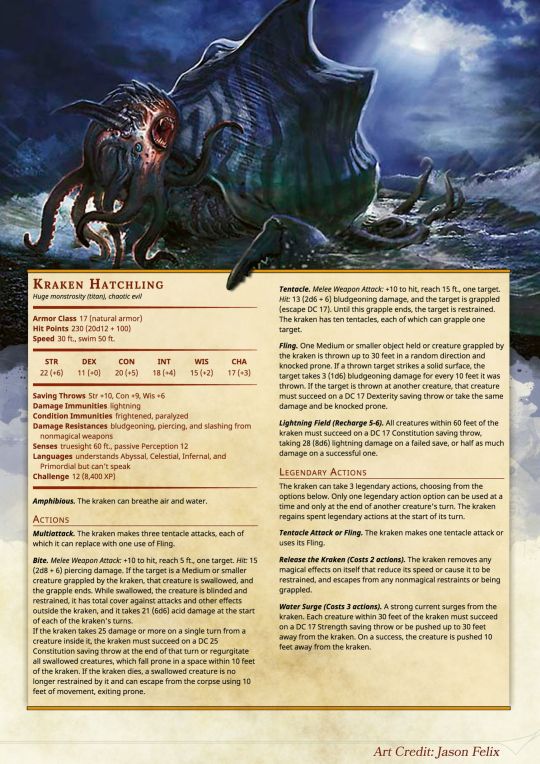
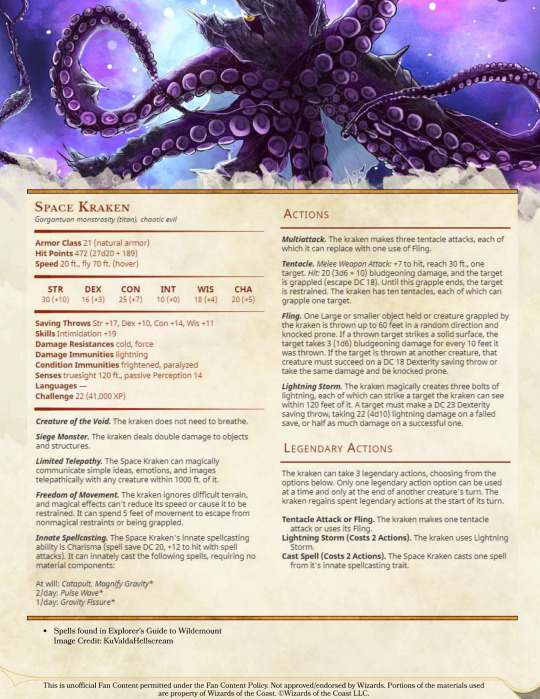

#dungeons & dragons#dnd#dungeons and dragons#homebrew 5e#5e#d&d#dungeons and dragons homebrew#ttrpg#5th ed#dungeons dragons#kraken#release the kraken#sea#deep#space#titan#monster
207 notes
·
View notes
Text


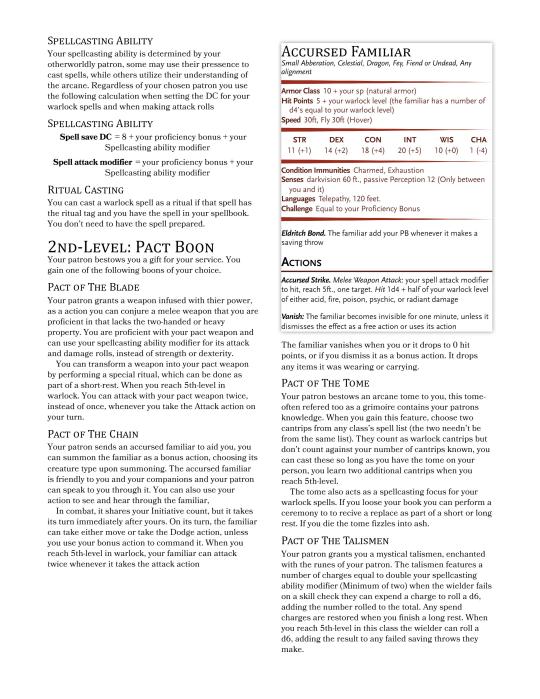



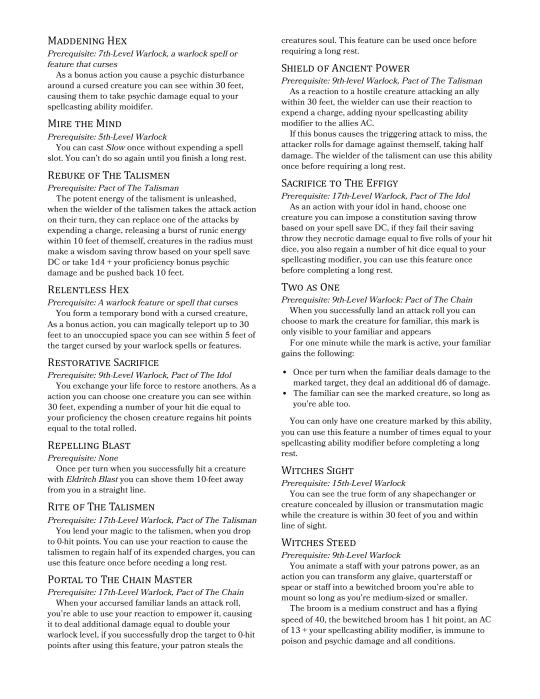


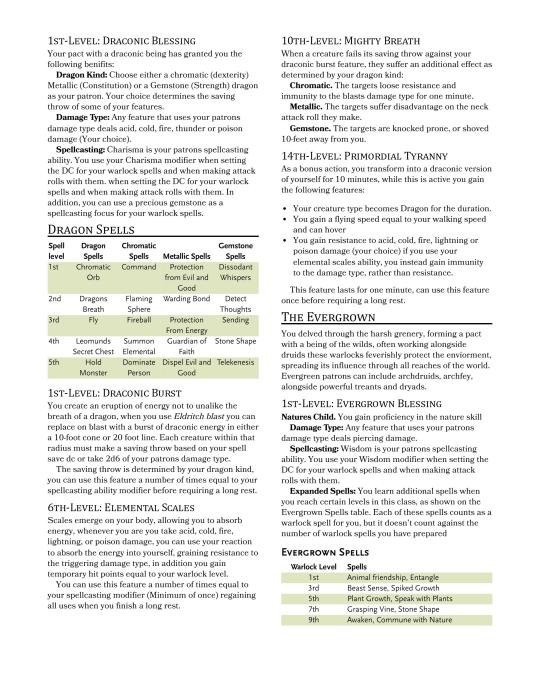


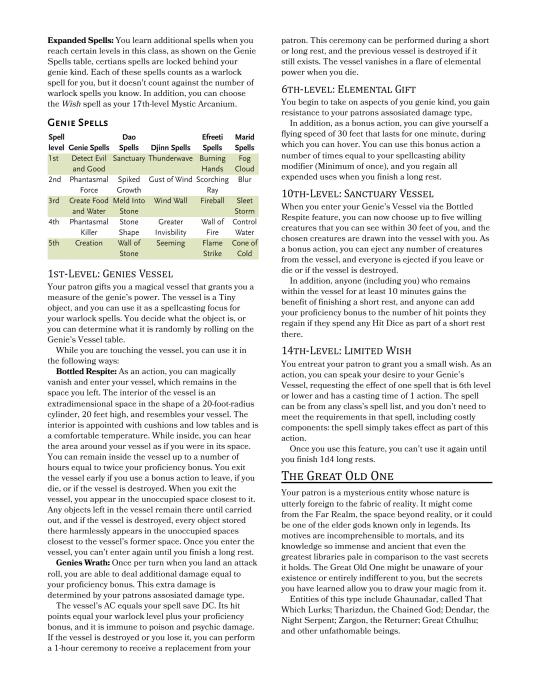





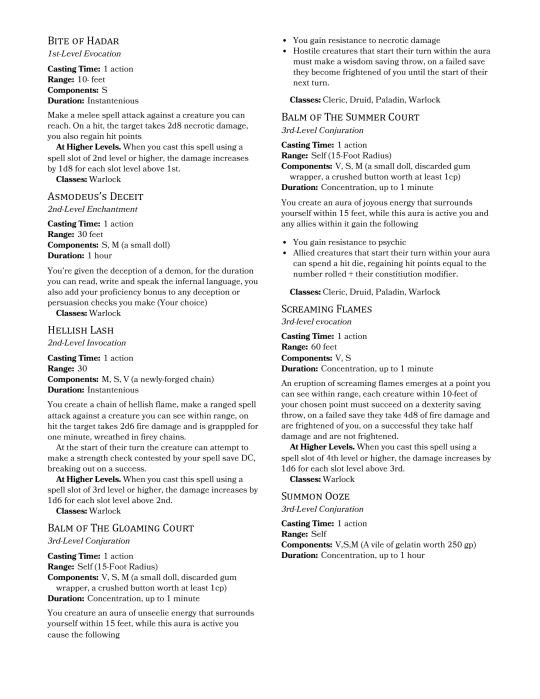

Hi there~!
It's been a long time coming, but here it is, my attempt at reworking the 5e warlock, due to my dissatisfaction with the version presented in One DND (5.5??) feature a whole host of reworked and altered options so you may be the best devil worshiper you can be, the rest of this post shall go over some of the changes made along with my intention behind the changes.
The base class.
For starters, eldritch blast is now a class feature. Simply put, every warlock takes eldritch blast, doesn't matter if you're focused on support, damage, or you're a weapon wielding hexblade, eldritch blast is such a good option, so I might as well give it as a base class feature. Similarly the agonizing blasts ability to add your charisma modifier to its damage rolls was added for similar reasons, skipping over the spellcasting, pact boon and invocation changes, the contact patron feature from the One DND UA was added for thematic purposes, and eldritch master was reworked to instead allow your patron to concentrate on a spell, which yes, does allow you to concentrate on two spells at one (At disadvantage)
Spellcasting.
The One DND warlock features the rather unique ability to choose between intelligence, wisdom or charisma as its casting stat, while I enjoyed the concept I decided to take it a step further by tying your spellcasting ability to the otherworldly patrons themselves, essentially using their spellcasting stat in a way.
Additional changes include you getting your 3rd-level slot at 6th-level as opposed to 11th, cause the highest most dnd campaigns reach are around 10-11th level, and it feels bad having to wait all the way until then just to cast three spells a day, some other changes of note include the warlock being able to ritually cast, and the spells gained from their otherworldly patron are now automatically prepared, rather than added to the warlock spell list. Which i'm not sure why they did that? Unless they though the warlock would be too good?
The Pact boons.
Basically every pact boon got upped in power, such as pact of the blade and pact of the chain, alongside them growing in strength when you reach 5th-level, in addition, two new pact boons were added. The first being the Pact of The Gunpowder, based on the Pact of The Trigger by MonkeyDM, its an eldritch blast/cantrip focused pact for those who want to truly commit themselves to the eldritch blast lifestyle, alongside the Pact of The Idol, allowing you to sacrifice your hit dice to perform various features.
Eldritch Invocations.
A selection of (Mostly new) invocations were made for this document, my favorite would have to be the ones given to the pact of the blade. Admittedly in the rush to get this out by the deadline I chose to cut back on the invocations in particular, but who knows, maybe when I get to revising this someday I can add even more invocations to the list.
Subclasses
All of the subclasses were revised in one way or another, but for the sake of time i'll go other three in particular: The Hexblade, The Horror and The Undying. The hexblade is a rather infamous subclass within the DND community in no small part cause of how strong a 1st-level dip is for many characters (Cough, paladin) but the more I looked at it, the more I found myself bored of it. Don't get me wrong the 5e hexblade is rather powerful, but it just doesn't scratch the itch of the cursed item patron, and with hex warriors main drawing being ported over to pact of the blade, reworking was a must. The horror (Originally called the undead) I generally don't have to many issues mechanics wise, in fact it's one of my favorite warlock subclass, my only gripe is cause of how much if steps on the undying toes flavor-wise, speaking of which, the undying is possibly the subclass I had the most fun reworking, transforming it into a tanky summon focused as opposed to....Whatever the original was trying to accomplish.
Along with the revision of old subclasses, three new subclasses are included: The Arcanist, The Dragon and The Evergreen. The arcanist is a pact with a powerful being of magic (Such as an archmage) it allows you to learn wizard spells from your pact magic feature, manipulate your spellcasting and eventually imbue spells into trinkets, the dragon are for those that simply want blast their foes away, you can create bursts of draconic energy, absorb elemental energy and even assume the form of a dragon, lastly the evergreen is for those that couldn't decide if they wanted to be a druid or a warlock, allowing you to create a garden around yourself that damages enemies, alongside implanting magic seeds within your foes and protecting allies within your garden against spells, similar to an ancients paladin.
New spells
Because I like making more work for myself, a handful of new spells are available at the end of the document, so I apologize if they're a bit on the lower end quality wise, but I hope they'll be at least somewhat interesting.
That's about all I wanted to talk about in relation to this rework, keep in mind everything in here is untested, and I encourage anyone reading this to leave any thoughts or constructive criticism they may have. With that in mind, thank you for reading, go out and make something cool.
#dnd homebrew#dnd5e#5e homebrew#dnd#homebrew 5e#5e#dnd warlock#dungeons and dragons#dungeons and dragons homebrew#dnd 5e homebrew#homebrew class#homebrew#5e warlock#warlock
84 notes
·
View notes
Text
I, Strahd: Depression, Psychosis, and Mental Health
Today I am going over how and where severe depression comes up in I, Strahd (1 and 2). We’ll look at what is wrong with him psychologically, explain the ‘diagnoses’, and go over where this can be seen in the novels.
In I, Strahd (1&2), two forces completely sway every facet of the story: The Dark Powers (TDP), and Strahd’s own fractured psyche. The former can be shooed to the realms of DM knowledge, but the latter casts a shadow over all of Strahd’s actions in the novels.So, when examining these books, we must either ignore his mind and get an inaccurate view of events, or deep-dive into his mental-health and learn to view the novels with such a lens in mind.
Welcome to Series 1; Strahd’s crippling depression
“Blackness surged up and clouded my brain for a time. This had happened before and was now becoming more frequent. I had thought it was simple illness before realizing it was but another part of my growing despair." (I, Strahd, p. 125)
Table of Contents:
1 -> Disclaimers to cover my ass and content warnings to cover yours
2 -> The actual essay on his depression (what y’all are here for)
(a) we’ll tell you what is up with him
(b) we’ll explain the ‘diagnosis’,
(c) we’ll finish with where we see this in the novels (i.e., our reasoning)
3 -> Our sources, further reading, and resources
4 -> My rambling authors note
== Disclaimers and Content Warning: ==
My background on the subject:
I am by no means a professional psychologist, but I am in training to be one. I also have extensive experience in writing for mentally ill characters, and neurotically strive for accurate portrayals. Indeed, it has become somewhat of a side hobby to prep for and run NPCs that grapple with themes of mental illness; a core theme which is present in most (if not all) of the games I run.
Beyond this- haphazard “resume” if you will, I personally fall into the category of what some people term “severe mental illness”. I have bipolar II disorder, which is characterized by periods of extreme depression and mild (hypo)mania. Unlike bipolar I, which is characterized by full-blown mania.
And, while every person is different, and this by no means denotes expertise, sometimes having an inside perspective sheds a lot of new light on the media we consume.
Disclaimer:
What this is: The essay below is purely for entertainment purposes for nerds who enjoy literature and this setting. It is meant to be a supplement for DMs who write for Strahd, and an interesting insight for everyone whose curious about the NPC.
What this isn’t: The content below does not reflect everyone’s experience with the disorder, nor is it meant to be a professional info-dump. My word is not law, nor is it claiming to be 100% professionally accurate. This is also not professional advice nor a guide for those struggling with mental health. If you are struggling with any of the difficulties described below, I have resources in section 3 to take a poke at.
Trigger/Content warning:
We’re talking about severe mental illness in the context of ravenloft. It’s already a bleak topic and now just wrapped in depression: the game setting. Because we’re using I, Strahd (1&2) as our main focus, I have to put in a CW for suicide. Because we’re covering depression in these books, there’s a general CW for the topic, along with a CW for discussions of psychosis and agitated states.
(TL;dr: Suicide, depression, psychosis and agitated states)
== I, Strahd: Diagnosis, Explanation, & Reasoning ==
“Secret and safe in some hidden cache within me, the blackness was always ready to rush forth and resume gnawing at my soul like a starved monster.”
(I, Strahd, p. 125-126)
{ I } ‘What’s Wrong’
Strahd likely has major depressive disorder (MDD) with mixed-features and psychotic features.
{ II } ‘What this means’
[1] Depression is far more diverse than most realize. It is not merely feeling extremely sad, exhausted, or melancholic. Nor is it always coupled with suicidality. Depression is also not only isolated episodes or only long term/persistent. For some people it can come episodically (MDD), for others it can be lowgrade and chronic over time (persistent depressive disorder (PDD)), and some individuals can suffer from a mix of both. Symptoms can also ebb and change over time, some individuals may go into remission, others may have increasing severity or begin having chronic issues, etc. etc.
(TL;dr: depression is pretty diverse so leave preconceived notions at the door, and remember that Strahd’s issues don’t reflect everyones struggles.)
Below I’ll be talking about two ‘features’ in depression. Mixed-features and psychotic features are essentially ways to describe a sub-cluster of symptoms that individuals can suffer from during depressive episodes (namely with MDD). An individual who suffers from various depressive ‘features’ might not suffer from them during every single depressive episode.
Finally, I’d like to note that an individual does not have to suffer from every single symptom to be considered depressed or to fit the criteria of certain features. Instead, there’s usually a minimum number of symptoms that must be met, alongside making sure context is taken into account, and how much those symptoms impair an individual’s functioning.
[2] Mixed-features (aka ‘agitated depression’)
Individuals during a mixed-features depressive episode experience the ‘usual’ depressive symptoms. They can feel:
Hopeless, apathetic, struggle to enjoy life experiences/unable to feel pleasure (anhedonia), feel extreme sadness or low mood, etc.
However, alongside these usual depressive symptoms, they can experience:
Racing thoughts, extreme physical restlessness, a chronic sense of being ‘on edge’, become impulsive, suffer from angry outbursts, and more.
A good example I’ll use is from my own experience with mixed-state depressive episodes, to help give the gist of how this looks:
Mixed-feature depressive states, for me, felt like my skin was crawling. I couldn’t stop thinking, my thoughts became a jumbled stream that needed to be vented or I’d explode. I felt constantly ready to snap at people because of that inner tension, coupled with a severe inability to simply feel happy, to enjoy anything, to have the motivation to even consider talking with or dealing with people. I felt miserable but, instead of simply wanting to curl up and sleep, my mind and body turned me into some depressed knockoff sonic.
I couldn’t sit and not in a hyperactive sense, but in the sense that the inner tension was pushing me into a state of constant pacing or activity. When I’m depressed, I tend to cling to escapism to try and ride out the gloom. During a mixed state, escapism takes on a frenetic quality. I have the energy to do things and need to vent the restlessness. And, I have the impulsivity and lack of mental clarity to launch into clearly stupid endeavors as if they were the most logical thing in the world.
Mixed states are like running down a steep slope while sleep deprived. Gravity is pulling you forward, so stopping quite literally isn’t an option- even as your body screams in exhaustion. To people externally, you look like you’re simply a runner- you’re not curled up in a puddle of tears like the titular picture of depression. But, internally, it’s all still there- the apathy, the misery. Except even you don’t necessarily have a moment to focus on the sorrow- because you’re too busy half tumbling down the mountainside.
(¹Individuals with depression (namely MDD) and individuals with bipolar disorder can both experience ‘mixed-features’ during depressive states. The difference is merely that individuals with depression don’t have separate manic episodes. Basically, both disorders suffer from depressive phases and those depressive phases can sometimes come with ‘mixed-features’.)
[3] Psychotic features (‘psychotic depression’)
Depression with psychotic features is very different from the psychosis in schizophrenia. Psychosis itself is not a disorder, it is a symptom cluster in which the brain loses contact with reality. Psychosis generally presents with delusions (thoughts or beliefs that unlikely or untrue) and/or hallucinations (these can be visual, auditory, tactile, etc. or a combination).
The difference between depression with psychotic features, and schizophrenia is that individuals with schizophrenia experience psychosis even when they are not depressed. An individual with MDD with psychotic features experiences delusions and/or hallucinations only during their depressive episode.
These delusions and hallucinations can be mood congruent or mood incongruent. That’s a fancy way of saying they can either relate to depressive themes (death, personal failure, guilt, etc.) or they do not relate to depressive themes.
A more ‘typical’ example of psychotic depression would be an individual with the symptoms of depression (low mood, lethargy, feelings of lack of self worth, hopelessness) alongside psychotic features such as being fully convinced they are to blame for an event, or that they are going to die of a disease.
{ III } Reasoning: Where we see it in the book
[1] Depression in general
Strahd, in general, is a rather blunt, deadpan, and nihilistic person. He’s an introvert, whose sense of humor generally consists of dark cryptic jokes or dryly bitching about some aspect of life. However, despite his- and most Barovians’- gloomy predispositions, there’s still a distinct difference between ‘Strahd just being Strahd’ and ‘Strahd is currently a dumpster fire’. (I.e., we can’t simply pawn off his ‘struggles’ as mere quirks of personality).
Furthermore, Strahd’s depressive issues are not isolated to after Barovia was slurped into ravenloft. Tatyana dying wasn’t simply what made him sad for eternity. This issue, was preexisting.
The following quote from I, Strahd (1) is a solid foundation for where the depression factors in before the fall of the demiplane:
“…my passion for war and obedience to duty had swept me from the home of my childhood, never to return. I had not seen my younger brother Sturm grow up, or been there for Sergei’s birth or for any of the thousand other joys that a man might take from the heart of his family. I had not even been able to attend the burial of our parents, four years past. Their deaths had occurred during the height of a particularly close and bitter campaign, and I could not be spared. I’d yet to see their graves. In some part of my mind, they were still alive as I’d last seen them three decades ago; Sergei’s presence had driven home the fact that this was not true.” (I, Strahd, p.64-65)
In the early book, before Tatyana is even in the picture, Strahd has a tendency to go on these wordy internal monologues about rather dark topics or observations about his life. He also has a pattern of these smatterings of melancholic, irritable, or angered internal commentary all cast in a very nihilistic haze. In a sense, there’s a lot of documented intrusive thoughts or preoccupations that get stamped aside to deal with whatever bullshit he’s currently tackling.
(And remember, as this is his journals’ narration, he’s very actively describing his thought processes from recent experiences. Along with scribbling down side commentary in his usual, rambling, stream of consciousness style.)
The quote I chose above^ is from an exchange between Strahd and Sergei. It’s one of their first times really ever speaking with each other one on one since Sergei’s arrival. It mostly consists of the pair making small talk about snippets of their past apart. Strahd, being Strahd, kicks the conversation off with a very dry joke about their dead parents. From there, it’s mostly downhill internally even as the spoken and external aspects of the conversation are rather mundane. It’s several pages of deadpan bitterness mostly consisting of commentary on their differences in upbringing and Strahd remarking on how, in comparison, he’s really lost a lot of what Sergei has (namely innocence and the ability to produce serotonin).
Exchanges like these are what I know a lot of people read as Strahd being self-absorbed, whiny, and self-pitying. And that’s exactly what it is! Except, the cause isn’t fully just selfishness.
By the start of I, Strahd- our titular future dark lord has come off of essentially a lifetime of combat and into the static peace of a dawning rulership. He’s spent a lifetime shoving things aside in order to keep moving forward. Now, those thoughts are catching up with him.
For, indeed, the exchange above blatantly admits that he’s barely even processed the death of his parents four years ago. Sergei's arrival is merely a catalyst after what has likely already been a steadily declining period for Strahd. Sergei puts into perspective a lot of things he’s never dealt with- and does so amidst a period where he’s already beginning to backslide. After all, It’s hard to try avoiding thinking about your complete loss of innocence and loveless childhood- when you’re standing next to the family member that isn’t traumatized.
As a person with depression, I can vouch firsthand for how self-absorbed one can become. And whiny. And self-pitying. You get stuck in your head as everything begins weighing you down- to the exclusion of the outside world. So, as ‘whiny’ as his exchanges can appear, they’re understandable. These are his inner thoughts and ruminations on topics which are already deeply depressing on a normal level. And the ruminations spiral further and further out of control as the book goes on.
[2] Mixed-features
From this point on, things go downhill- and go downhill fast. His side-commentary rants grow more and more frequent as he begins to ruminate further and further on various topics. Externally his mood takes a bit more of a sour turn, to the point that he even notes the vaguely concerned commentary of others.
By the time Tatyana enters the picture, he’s stuck in his head. After she’s on stage, his behavior becomes objectively abnormal and worrying. He becomes obsessive, to put it mildly, and erratic.
In mixed depressive states (and in hypomanic/manic episodes for bipolar folks), there’s a symptom cluster I’ve held off on covering until now (for dramatic effect, ofc):
- Increase in energy or goal-directed activity
- Increased or excessive involvement in activities that have a high potential for painful consequences
For those in a mixed-feature depressive episode that suffer from these symptoms, you’ll see an ability to commit to and methodically complete some goal. They’ll have the energy to do so and do so with almost neurotic abandon. You’ll also see them plunge into extremely risky activities or set off towards goals that are clearly a very bad idea.
The way I like to describe it is that, in such a state, self-control goes out the window and everything seems like a totally plausible and great idea. It’s like removing the brakes from a car that’s heading down a mountain. There’s no real stopping. There’s just steering towards whatever looks best.
I, Strahd, Part II, chapter 4 is possibly the best unintentional literary portrayal of a mixed-features depressive state that I’ve ever come across. We see him obsessively working to find some sort of magical solution to his Tatyana problem. The recounting of this event coincides with a stream-of-consciousness commentary that grows more out of touch with reality by the minute.
It begins with a blowout fight between Strahd and Lady Illona. Lady Illona attempts to confront Strahd about a previous blowup he’d had over Tatyana and Sergei gifting expensive jewelry to a peasant. The previous exchange had already been uncharacteristic of the man but his fight with Illona- though it openly ends with minimal damage- was internally out of left field.
“Anger such as I’d never known before burned through me from the bones outward. I felt that if I held on long enough to the chair arms, they would kindle into flame from the heat.” (I, Strahd, p. 121)
His rambling internal thought process transitions from his irritation with Tatyana to a convoluted path of fractured logic. I’m going to give you a very janky outline of the thought process which spans the first 5 pages of the chapter, to exemplify the racing thoughts and erratic behavior:
Tatyana+Sergei give necklace to peasant -> peasant may just be taking advantage of their charity -> [insert spontaneous angry outburst] -> [Insert another spontaneous angry outburst] -> she shouldn’t have done that because it was stupid and I also gave them the necklace -> she’s naïve and needs guidance from someone that’s not an idiot -> You know whose also an idiot? Sergei -> yo sergei might actually just get completely shivved for being too nice -> God that’d be really sad for Tatyana -> damn they’ll be leaving after the wedding -> I could convince them to stay -> god I’m fucking jealous of Sergei -> God I really like tatyana -> [>out-of-nowhere paragraph about crippling depression<] -> one page of random observations about the castle rn -> Alek fun facts -> you know what alek got me once? Books, magic books -> [*Immediately tangents off to go neurotically study them*]
(I, Strahd p. 119-124)
Strahd is a strange person overall. However, he’s not this strange. Not consistently, at least. In the book, before Sergei and Tatyana were on scene (i.e., before his mental state began to tank), we really don’t see any behavior to this degree of unhinged. The writing itself also physically becomes increasingly more erratic as his mental state declines. The way his prose is structured, especially during Part II, Chapter 4, fluctuates rapidly between rambling paragraphs with barely cohesive themes to short staccato sentences of random thought and observation.
(TL;dr: he wasn’t this weird before. This abrupt shift is abnormal and is telltale evidence that he’s in an altered mental state)
[3] Psychotic features
I hesitated adding the section at first, because this is where the lines between reality, psychosis, and magic blur. However, after a great deal of agonizing over my Word doc, I decided to keep this section in.
Because of the nature of psychosis, and because the only recounting we have is from his point of view, we will never be able to truly know what was, and was not, the product of The Dark Powers (TDP). Specifically, this dilemma arises when discussing hallucinations. However, it can also be seen in certain delusions as well.
Before the point in the chapter where voices begin to speak to him out of the darkness, we do see signs of preceding delusional thought processes. This is yet another blurred line; as the racing thoughts and impulsivity of a mixed state and the beginnings of a truly delusional belief intermingle. The latter certainly evolved from the former. What was likely the impulsive internal ramblings of a declining mind evolved into a cemented believe that is utterly out of touch with reality. Of course, I speak of his obsession with Tatiana and his perception of her. Though, I think we can all agree that it worsened in warped closer to the wedding he drew. And, after the wedding, became irrevocably nonsensical.
What I do not term as delusion is his idea that resorting to dark magic was the best way to deal with his “Tatyana problem”. This more exemplifies the “rationally irrational” thinking of a mixed state. There is still a grounding in reality. Using dark magic is a realistic option, it does avoid having to actively do something horrid to other people (or, it did initially). However, it also runs the risk of irrevocably fucking him over in some unseen, cosmic way. But, this is where the impulsivity comes in. The brakes are off the car. That road looked like a good idea in the moment, even though he flew straight past the ‘cliff ahead’ sign.
““That’s a very old book, you should handle it more carefully.” The voice- coming from everywhere and nowhere- took me cold.” (I, Strahd, p. 129)
Throughout the rest of the chapter, and then the rest of the book, and then the next book, and, ultimately, the eternity of his existence– voices periodically surface during his deep depressive states.
I would certainly term the hallucinations, if that’s what some of them are, as mood congruent. They arise in moments of true despair or panic during his less than lucid states. Tatiana’s death, for example, elicits a truly horrifying internal cacophony of laughter and other skin crawling things. Indeed, these moments are among the most chilling across all of the Ravenloft Dark Lord novels. And, or certainly the most chilling and I, Strahd (1&2).
Strahd certainly suffers from depressive delusions, that is some thing I personally don’t see as up for debate. Indeed, this rambling paper alone barely scratches the surface of examples in the books.
Hallucinations, however, are lost in a grey area that even I cannot wholly detangle. So, the best we can afford is speculation.
(TL;dr: he meets the criteria for depression with psychotic features overall, but whether or not he hallucinates is up in the air)
Are they Hallucinations or TDP?
I will keep this section short, because it is speculative in the end. And, I encourage y’all to puzzle it over yourselves, as it is a truly interesting dilemma.
Personally, I do think he may have moments of hallucination. However, TDP can easily latch onto these moments and make them far far worse. They can also keep him guessing as to what is him going mad and what is their meddling taunts. A lot of his ‘hallucinations’ are dark powers, especially during the events surrounding the wedding night. Afterwards, however, there are certainly moments that I could see being merely crafted by his own despair.
The second novel, one which I find to be the most entertaining comedy in the Ravenloft pantheon, begins with a suicide attempt.
I’m not going to recount this in detail or put quotes in, the novel is accessible online if you’d like to read in detail, however, essentially consists of Strahd throwing himself from a high place after the death of yet another Tatyana.
This moment is significant in Ravenloft 2e’s history, because it is the first time we learned that a dark Lord cannot die. However, is still a suicide attempt and the imagery and auditory hallucinations surrounding it are subtle enough to where they could very well be sourced merely from his own mind. And not the dark powers.
Suicidal Ideation in I, Strahd: War Against Azalin
Rounding out on a happy note, I wanted to take a brief moment to talk about the aforementioned suicide attempt. In the latter half of the first novel, Strahd essentially spends several years in a deep depressive slump locked in his castle. Thoughts of despair are rarely far from the page, however, we never see any active attempts to end things. This changes in the second novel and sets an unsettling precedent.
In the grand scheme of things, his initial attempt takes place fairly early in the history of 2e Ravenloft. Indeed, he hadn’t even met the likes of Madam Eva. And this is worrying, because it sets a precedent of suicidal ideation and self harm practically from the beginning- long before adventurers even have an inkling of the mists, let alone find themselves ensnared by them.
Into “modern nights” he likely still struggles with such tendencies during depressive episodes. After all, Strahd is in an environment which actively seeks to eviscerate everyone’s mental well-being. Because of this, it would essentially take an act of god to wrench him from depressive cycling. But the gods cannot save you in Ravenloft, especially not in second edition¹.
And so, Strahd is left with probably the most unseen aspect of his curse: the inability to truly be free of despair.
== Sources, Further Reading, and Resources ==
🦇Ravenloft Sources:
I, Strahd: The Memoirs of a Vampire. P.N. Elrod (1993)
I, Strahd: The War Against Azalin. P.N. Elrod (1998)
¹Domains of Dread. William W. Connors & Steve Miller (1997)
🔬Non-Ravenloft Sources used:
(I suggest poking the links in yellow for further reading if you're curious!)
- American Psychiatric Association. (2022). Diagnostic and statistical manual of
mental disorders (5th ed., text rev.). doi link
- Hooley, J. M., Nock, M., & Butcher, J. N. (2021). Abnormal psychology. Pearson.
- Koukopoulos, A., & Koukopoulos, A. (1999). Agitated depression as a mixed state
and the problem of melancholia. Psychiatric Clinics of North America, 22(3), 547-
564. doi link
- Gillette, H. (2021, December 22). Agitated depression: Definition, symptoms, and
treatments. Psych Central. Website link
- Major depression with psychotic features. Mount Sinai Health System. (n.d.-b).
Website link
- Black, R. (2022, September 14). Psychotic depression: What it is and what you
should know. Psycom. Website Link
🧠 Mental Health Resources:
Feeling agitated, scattered, or having low mood doesn't necessarily mean one is suffering from a depressive disorder. Life is rough, sadness and rough patches are part of the gig. However, if you, or someone you know, are considering self-harm or experiencing suicidal ideation, you aren't alone. I am not a professional, but here are immediate resources:
Call the National Suicide Prevention Lifeline 24 hours a day at 800-273-8255.
Text “HOME” to the Crisis Text Line at 741741.
== My Obligatory Rambling Author's Note ==
Hey, congratulations on making it all the way through! Have a croissant 🥐
I've had this post in the works for... 2 years now? And I will say, I'm glad I waited to scrape things together. I've gained a lot of perspective and knowledge which has helped me hone this... rambling word vomit into a cohesive(ish) form.
"It wasn’t until college that I realized why I, Strahd had almost eerily familiar undertones to it all. Indeed, the prelude to that fated wedding gave almost a strange sense of DeJa’Vu when reading it for the first time in late high school.
After I was diagnosed with bipolar II during the summer between freshman and sophomore year, I finally had the words and context to realize why things looked so eerily familiar. The sudden erratic turn to a goal or obsession out of left field, the nights spent feverishly, methodically, hurtling towards some clearly delusional doom as if it were the most logical thing in the world? I’d seen facets of it before many, many times. And I’d also seen the crippling, self-destructive, anguish of deep depression."
(Scrapped draft, p. 9-10)
All of us have that one character in literature/film/tv that's just... special or impactful. Whatever arcs or journeys they've followed have somehow personally touched us and come at an important time in our lives. They're special in a way that's hard to articulate. Unfortunately, Strahd happens to be mine- and it's largely because of the everything^^^ mentioned above (minus the psychosis, I thankfully have been spared that struggle).
I have yet to come across another character that struggles with mixed-features in depression, to this degree. But beyond that, I also bumped into I, Strahd (and Strahd as an NPC via the CoS module) when I was in high school. This was a time where I was beginning to subclinically cycle through lowgrade depressive and hypomanic episodes. It was a very dark time, and that hot mess of an NPC happened to be one of the few things that was more of a hot mess than I was. As bad as things got, especially in early college before I was medicated, at least I never plunged my house into a demiplane- ya know?
It's strange what we take small comforts in. But, it's too late to pick a different one. I'm already too deep in the vintage Ravenloft book collection to turn back now. That, and, when you struggle with something oddly niche? You take the rep where you can. Even if that "where" happens to be a generally villainous dark lord with the social graces of a irritable toad.
Any ways, thanks for sticking with this! I know it's long, depressing (no duh) and a bit incohesive. I'm a dyslexic writer, so, cohesion can be a bit difficult at times.
If I have time, I will do a part 2 on analyzing his illness' implications on the books (namely his culpability in stuff). And a part 3 on writing for/running this type of mental illness, if folks are interested. I've been running this strange creature for... many years now. And have good writing samples from pbp games i've run for folks looking for inspo on how to pull off the... the everything above^
- Catslug
#in this essay i will#strahd von zarovich#strahd#curse of strahd#ravenloft#dnd#dungeon master#ravenloft2e#catslug essay#dungeons and dragons homebrew
53 notes
·
View notes
Text
Dimeritium, the cursed, wicked silver


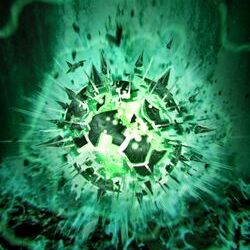
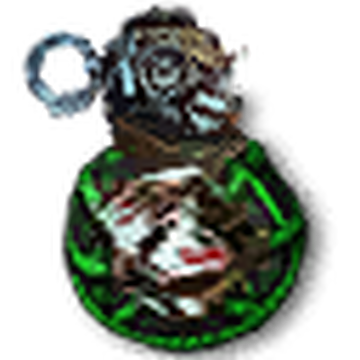

Common, metal, weapon, armor, ammo, throwable
Dimeritium or it's common language name, cursed or wicked silver is a rare type of silver like mithril however dimeritium is an illegal metal it can still do extra harm to devils, demons, monsters and undead much like mithril and regular silver but it also drains the magic of those who are touched by it
In it's ore form it looks completely black like that of obsidian but when in it's ingot form it looks like silver but gives off a sickly bright lime green tint unlike mithril which gives off a pure pale blue tint
Dimeritium is illegal due to it's magic harming properties it is mainly used by "witch" hunters who are considered criminals due to the people they hunt are either innocent mages and nonhumans and they make bombs, weapons, armor, ammo and shackles out of dimeritium
#dnd#d&d homebrew#dnd homebrew#dnd 5e homebrew#dnd 5e#dungeons and dragons homebrew#dungeons and dragons 5e homebrew#dungeons and dragons 5e#dungeons and dragons#d&d 5e homebrew#d&d 5e#d&d#the witcher 2#the witcher 1#the witcher 2: assassins of kings#the witcher 3#the witcher#the witcher 3: wild hunt#the witcher games#the witcher books#dimeritium#witch hunters#witch hunter#mage hunter#mage hunters#witch hunt#witch hunts#mage hunt#mage hunts
42 notes
·
View notes
Text


Getting really really into my dnd lore againnn
[Commissions are open! Check out my ko-fi!]
#art#dnd#dungeons and dragons#rosyart#original character#oc#artists on tumblr#artist on tumblr#high elf#homebrew#dnd homebrew#drow#sea elf#wood elf#tiefling#dungeons and dragons homebrew#lorvyn
27 notes
·
View notes
Text
I made some eldtritch invocations for the archfey patron and I would like some feedback.




Currently going through the dnd classes and buffing/ changing them for my group cause we identified that a few classes need buffs with our playstyle. And after buffing monk and sorcerer, warlock was next on the chopping block. The main class is reworked and I feel pretty good about it, the archfey subclass is the only subclass done so far but I felt like making unique invocations for each subclass. Here are some for the archfey and I feel like they are kinda busted (our group plays to high level and even then I think some of this is too good) and I would like to know what people think about it. Especially cause I want to learn when it comes to writing homebrew cause I am kinda tempted to put up some of the custom subclasses I have in my mind and written down up somewhere, but only if I feel like that I can actually write something somewhat good (trust me you do not want to know the busted piece of shit that my homebrew pyromancer sorcerer is for example, the only reason it has not killed my game yet is cause the player is not that good with the game mechanics and).
#dungeons and dragons#dnd5e#dnd#dnd 5e#dnd homebrew#dnd stuff#ttrpg#dungeons and dragons homebrew#homebrew#d&d 5e#dnd 5e homebrew#5e#dnd warlock#warlock#archfey#archfey patron
22 notes
·
View notes
Text
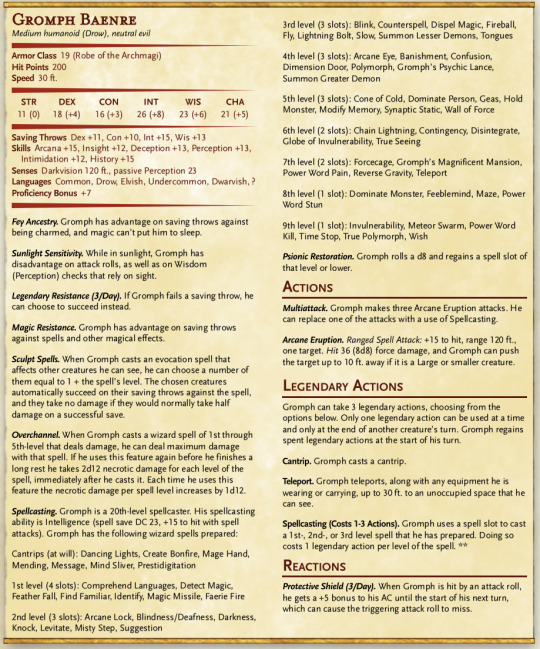
Since there seem to be at least a few people in need of a Gromph Stat Block I've decided to share mine.
Please keep in mind I don't do this professionally at all and do not have that much experience when it comes to building these and balancing them. (Which is why i didn't give him a CR)
#dnd#dungeons and dragons#legend of drizzt#the legend of drizzt#forgotten realms#dnd drow#drow elf#drow#gromph#archmage gromph#gromph baenre#dnd stats#dnd stat block#dnd wizard#dnd wizard stat block#Out of the Abyss#dnd 5e#dnd homebrew#dungeons and dragons 5e#dungeons and dragons homebrew#dnd 5e stat block#dnd 5e stats#menzoberranzan
32 notes
·
View notes
Text
Me: Hey Brain, can I have some motivation to do homework?
Brain: No, but I can give you a two-for-one special on Homebrew Eldritch Invocations.

#dnd#dungeons & dragons#Dungeons and Dragons#dungeons and dragons homebrew#dungeons and dragons 5e#dungeons and dragons homebrew 5e#dnd 5e homebrew#dnd homebrew 5e#dnd homebrew#eldritch invocations#warlock
214 notes
·
View notes
Text
Bodily Affirmation
1st-level transmutation (ritual)
Casting Time: 1 minute
Range: Touch
Components: V, S, M (powdered frog bones)
Duration: Instantaneous
You reshape the body of a willing creature in range, changing some or all of their body to match their ideal appearance. The creature must consent to any and all changes made by the spell, if they do not consent, the spell fails. The spell can only change physical appearance and biological sex within the bounds of what is possible for the target creature’s race. The changes last for 7 days, and painlessly disappear at the end of the duration.
Casting this spell on the same creature with the same changes once every 7 days for a year makes the changes permanent.
Classes: Artificer, Cleric, Druid
Spell for D&D 5e I made. I wanted to make fantasy HRT because I thought that would be cool and allow for more character creation options. Doubles as cosmetic surgery as well.
All my spells
#trans rights#transgender#dungeons and dragons#D&D#d&d homebrew#dungeons and dragons homebrew#homebrew#spell#d&d#D&D spell#d&d stuff#dnd homebrew#trans#dnd spell
177 notes
·
View notes
Text
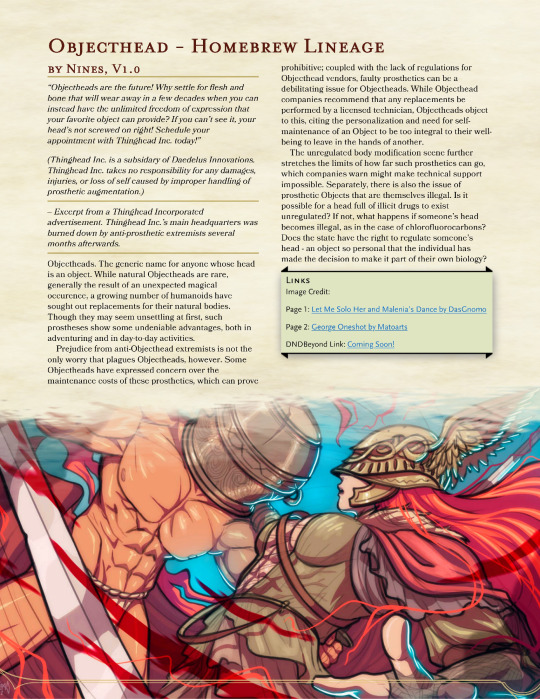
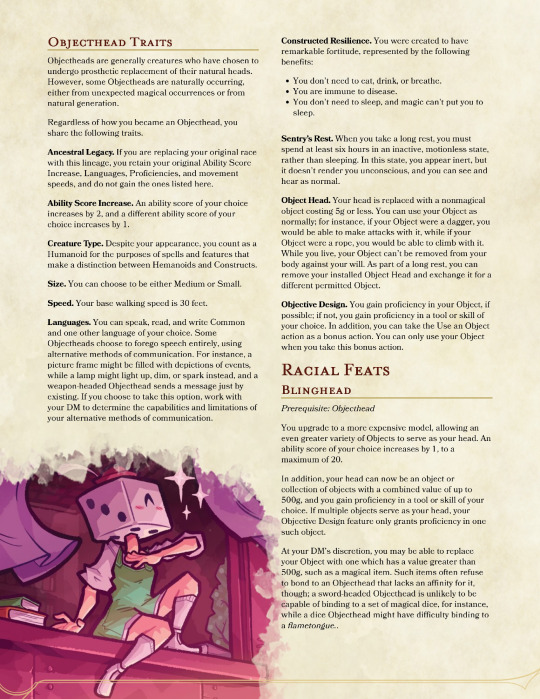
Objecthead - Homebrew Lineage by Nines, v1.0
Heads will roll... the dice.
Objectheads, as the name implies, have an object for a head. While this allows them to transcend many physical limitations, such as the need for food and sleep, they still need to keep their head on to survive - so maybe don't try replacing your head with a Revivify diamond.
#my homebrew#homebrew race#d&d race#dnd races#race#dungeons and dragons homebrew#dungeons and dragons 5e#dungeons and dragons#d&d 5e#d&d#5e dnd#dnd 5e homebrew#dnd homebrew#dnd#homebrew 5e#d&d homebrew#homebrew#5e homebrew#5e d&d#dnd 5e#5e#object head
234 notes
·
View notes
Text
Hyrdomancies

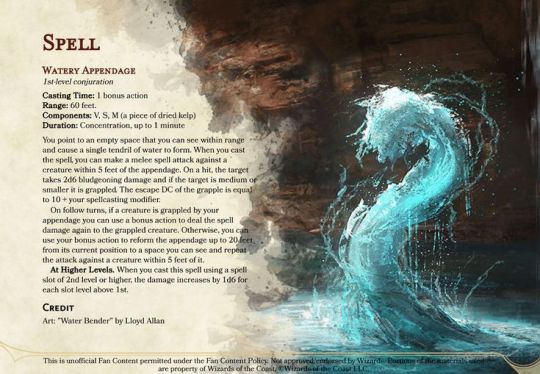



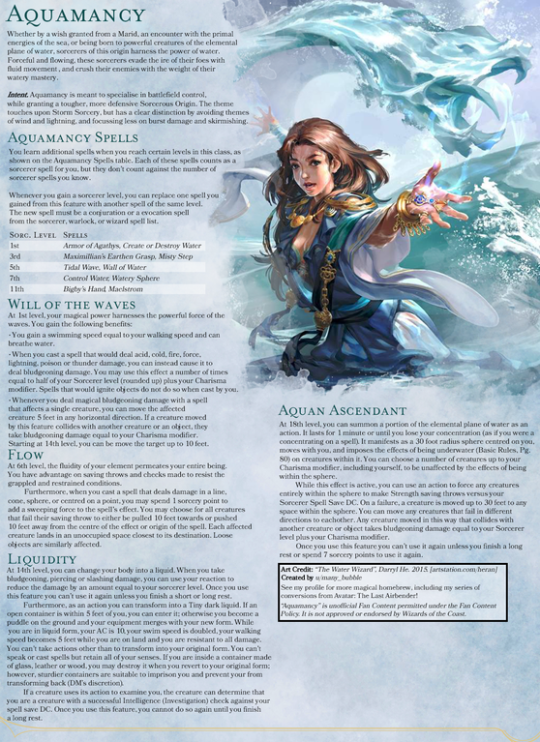
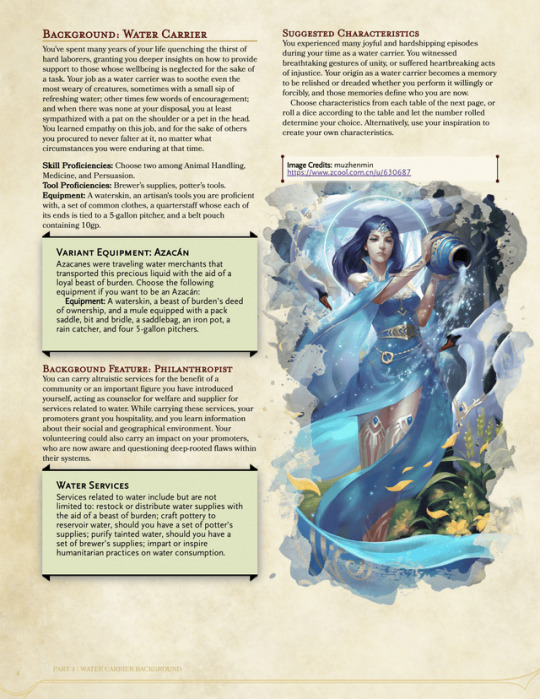

#dungeons & dragons#dnd#dungeons and dragons#homebrew 5e#5e#d&d#dungeons and dragons homebrew#ttrpg#5th ed#dungeons dragons#hydromancy#water#waterbending#underwater#power#superpowers#drowning#dive
248 notes
·
View notes
Text
Homebrew Class design For Dummies: Part 4: Class Resources
Hi there~! Hope you're having a lovely day. Welcome to the fourth-edition of Homebrew Class Design for Dummies, if you haven't read part 1, 2 and 3 click the links there. But in case you're new here, this is a series of write up i've decided to write to help anyone who wants to make a custom class for Fifth-Edition.
What is a Class Resource.
A class recourse, as the name implies is a resource pool that the player has to keep track off as they play that class. The most obvious example of this is Monks Ki points and Sorcerers Sorcery points,. Though these can also show up in other, much smaller ways. such as Channel Divinity on clerics and Lay on Hands for paladins.
If you don't wanna come up with an entirely new resource pool, then you can also look to other resources, such as spell slots, hit points or even hit dice as your classes resource if you really want too.
The Monk Problem
An issue that can come up with class-specific resource pools is that your class needs to expend it to do just about anything, this is most obviously showcased by 5e's Monk. Monk has several problems I might make a write-up on in the future, but for now i'll go over its Ki feature.
Monk has a resource known as KI, you gain an amount of ki points equal to your monk levels, which you regain on a short or long rest. You use your Ki points to fuel the following: Flurry of Blows, Patient Defense, Step of The Wind, Deflect Missiles (To make an attack roll) Stunning Strike, Diamond Soul (To reroll a saving throw) and Empty Body. If you include the optional class features then you also can include Ki-Fueled Attack, Quicken healing and Focused-Aim. That's 7-10 features. Now add also add on top of that how you have very limited ki in actual play (1st-12th-level) and that you don't have a way to reliable recover Ki mid-fight, it leads to an overall bad play experience, no one likes to operate at half capacity for most of the adventuring day.
Solutions
An obvious solution to the monk problem is to give them a way to regenerate their resource in the midst of combat, maybe your class can regain their specific resource by dropping a creature to 0-hit points, or after a critical hit. Or maybe they can spend an action to recover spent uses of their resource. Though if you plan to use the former, make sure you put a CR cap so the player can't punch a couple rats to regain their resource. That's called the "Bag of Rats' If you're curious. Keep how your resource is used because a way to easily recover it might not always work depending on the class.
Using a Class Resource
Okay, so your class has a resource pool they need to manage, sweet. But now you have to figure out how your class uses said resource, is it used to amplify your classes existing feature similar to sorcery points or superiority dice? Or is it used to create new effects. Generally what your classes resource does should be used to enforce the playstyle you envision. Say for example you want your class to be a healer, allow them to heal and cleanse effects using said feature.
while this might seem obvious to some, your classes special resource should also be incorporated in some way into their subclasses, otherwise stick to PB times per day or X modifier times per day. Which nicely segways me onto:
Tracking
Something to look out for when making a class with a resource pool is making sure there isn't too much tracking involved. An immediate example that comes to mind is the UA Mystic, which could gain up to 71 psi point at the highest levels. Which is an issue cause no where else in D&D do you have to track that, but unlike Lay on Hands, it's not like you're tracking an even number either (5 per level) the result is that it becomes cumbersome to constantly look back at the document or your sheet to track how many you have. Another example of which is the Psionic Soul Sorcerer, which added a second resource in the form if PSI Dice to the Sorcerers kit, which leads to confusion since you're juggling two big pools at once.
In general it's a good idea to limit tracking where you can, you can even make your classes main resource unlimited use, which yes would require more to keep balanced, but it'll go a long way in making your class easy to pick up and play.
Summary
To summarize the points of this write up, when making a class resource you should:
Figure out how the resource pool manifests. (Points, die, etc)
Make sure it fits within your classes overall themes and playstyle.
Keep tracking as limited as you can (Or want)
Experiment with it
The Avatar
Last but not least, I will give a little update on the Avatar. Since I last posted I decided to scrap the radiance die because simply put, I couldn't think of how to make them interesting to use without treading too much on other features, much less how to incorporate them into subclass progression. And personally, epithets feel much more like an avatar thing than the radiance dice ever did.
In exchange. Avatars that reach 6th-level can now cause an epithet to ascend, which reads as follows:
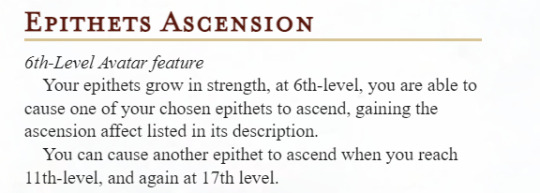
The idea behind it is that if you have an epithet you really enjoy using, you can have it ascend and cause it to become stronger. It's also meant to help keep the epithets viable as you gain levels in this class, an example of this is the Mighty epithet, where if you cause it to ascend, as shown here:
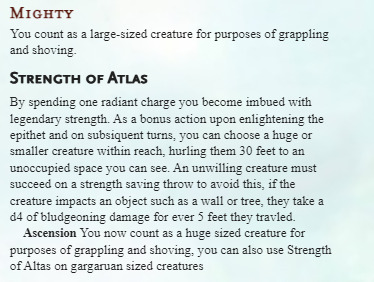
Holy hell, I am so sorry for taking this long on the series. I got caught up with other projects + reworking the avatar itself, so this ended up being put on the backburner until now. Hopefully I can get the next entry: Subclasses out in a timely manner, but we shall see.
But that's all I have for today, make sure to like + share my content if you enjoy, have a nice day, go out and make some homebrew.
Homebrew Class design For Dummies: Part 1: The Foundation
Homebrew Class design For Dummies: Part 2: Getting Started
Homebrew Class design For Dummies: Part 3: Finishing the base class
Guide to Balancing Classes
#dnd homebrew#5e homebrew#dnd#dnd5e#homebrew 5e#5e#dnd 5e homebrew#dungeons and dragons#dungeons and dragons homebrew
46 notes
·
View notes
Text
A collection of all the Warped statblocks I've made so far:




Let me know if I need to rebalance them or adjust their CRs, I have no idea what I'm doing.
#belior's guide to the realms of chaos#dnd homebrew#dnd5e#dnd#d&d homebrew#d&d 5e#d&d#dungeons and dragons homebrew#dungeons and dragons
21 notes
·
View notes
Photo


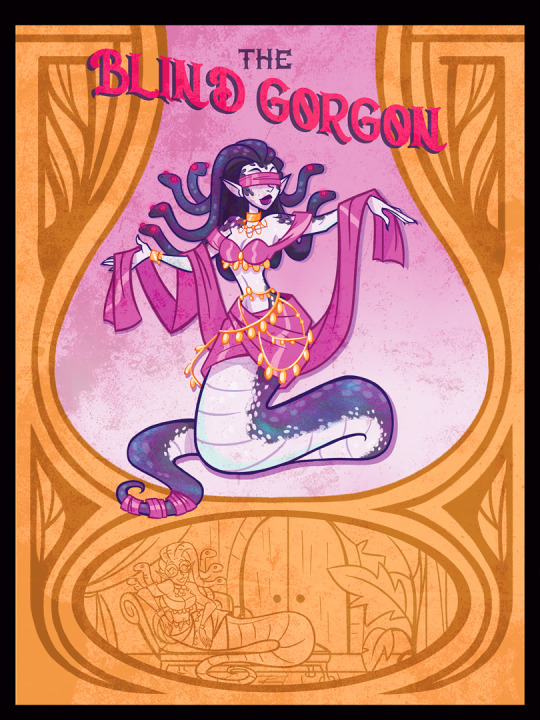
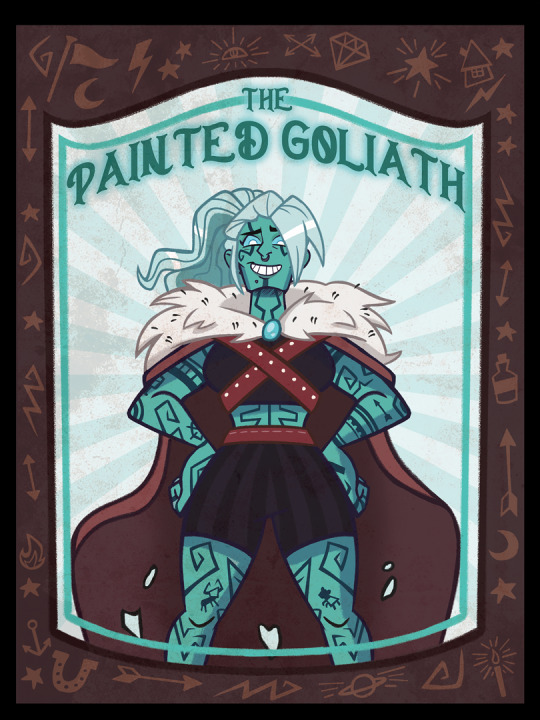

When we ran our first session of “Bergon’s Big Top,” it was right after we were all finally able to gather in meatspace following the pandemic and I vowed to try and make DND more memorable when we all made the effort to get together. I was getting tired of trying to play behind computer screens.
So, I made a ton of food, decorated the whole apartment like a circus with spotlights and all, made a party playlist, wore various costumes, had props, and honestly just went all out for the occasion to try and make it a memorable time. Pandemic was another reminder that you can’t take for granted the time you have with the people you love, so that was my way of trying to utilize our ability to have fun playing DND in person after a long two years of separation.
This was an extension of that idea, lol. I made act posters for all of my players featuring their DND characters and the acts that they perform at the circus. Everybody got to keep a big fat print of theirs as a souvenir. They were so fun to make! I love this gang!!
#dungeons and dragons#dnd#dnd homebrew#dungeons and dragons homebrew#bergon's big top#bergons big top#kritterart#ttrpg#dnd circus
137 notes
·
View notes